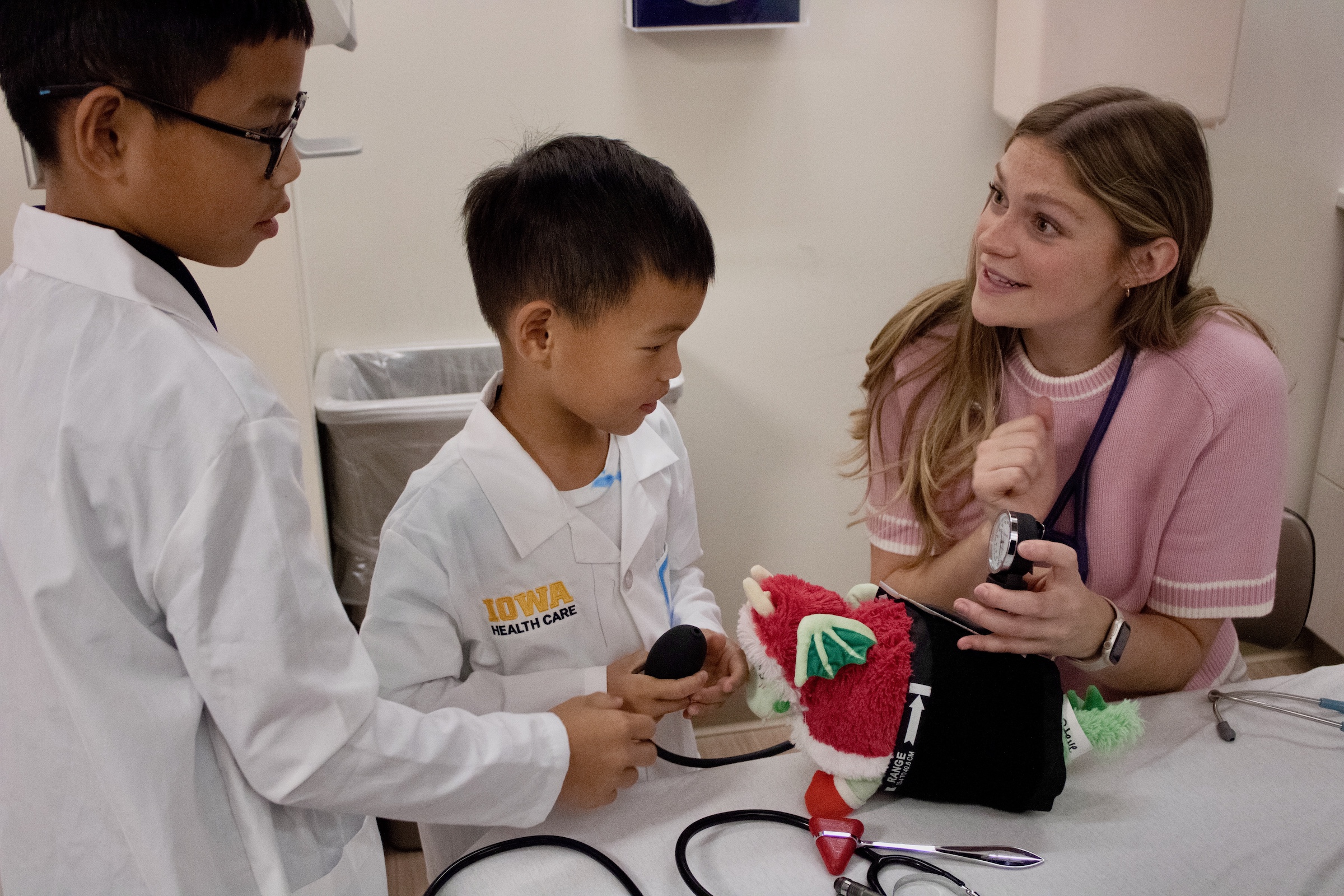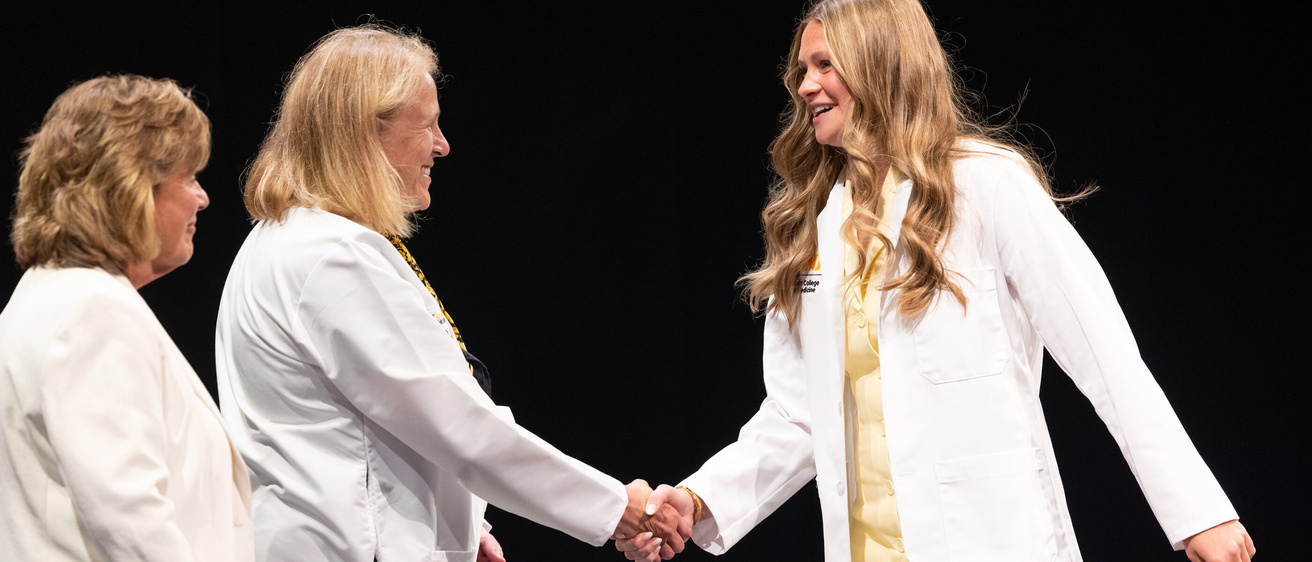Algona, Iowa, isn’t just where Reese Rosenmeyer grew up. It’s a main driver behind her desire to pursue medicine.
“My graduating class was 42 students, so very small,” she says. “That gave me the chance to do everything — sports, music, drama — and I’m grateful for that. Growing up in a rural place really shaped me.”
It also opened her eyes to access gaps in rural care. Her grandfather’s chemotherapy treatments required long drives, and her father took a substantial amount of time off work to take him to appointments.
Because her mother worked as a nurse practitioner in their tight-knit community, Rosenmeyer also learned about the upsides of rural health care while growing up.
“She would have patients stop us in the grocery store just to thank her,” Rosenmeyer recalls. “Seeing how much her patients appreciated her care was very eye-opening. That really speaks to what it’s like to serve a rural area.”
Discovering CRISP
When Rosenmeyer learned about the Carver Rural Iowa Scholars Program (CRISP) within the University of Iowa Carver College of Medicine while applying to medical school, she knew she’d found her fit. CRISP is designed to recruit students with rural roots or who are otherwise interested in rural health care and then give them the support to practice in the communities where they are needed most.
The program prepares medical students to practice in rural communities through mentorship, rural clinical placements, and loan repayment incentives of up to $100,000 for those who return to practice in qualifying Iowa communities for five years.
“Next summer, all of the CRISP candidates in my class will do a program called MECO — Medical Education Community Orientation,” Rosenmeyer says. “Basically, you’re getting to work with rural doctors and learn what makes that rural health care so unique. It’s such a great way to better understand how to provide real care while you’re still in the med school curriculum.”
CRISP is one of several ways University of Iowa Health Care is directly addressing the physician workforce shortage in Iowa. Rural areas are seeing some of the biggest impacts — a mother driving long distances to deliver her baby, a farmer waiting months for a check-up, or a child without access to a mental health provider.
UI Health Care recently expanded CRISP from four to eight students per class. Of the students who were involved in CRISP and have completed residency, 83% are currently practicing in Iowa. Of those CRISP graduates in Iowa, 86% currently practice in rural Iowa. The number will grow to 93% in early 2026 after an alumna completes her fellowship.
Rosenmeyer says her CRISP cohort already feels like home.
“We’ve been able to get to know each other better, and we’re all from smaller towns in Iowa,” Rosenmeyer says. “It’s another way I’ve been able to find a smaller community within a larger class.”

Why CRISP matters
Rosenmeyer is just the kind of student that CRISP is looking for.
“If you grew up in a small town, you know the pace of life, you understand the needs, and you can see yourself thriving there,” says Greg Nelson, MA, RN, assistant dean and director of the UI Health Care’s Office of Statewide Clinical Education Programs.
For Rosenmeyer, CRISP isn’t just about training. It’s about helping Iowa communities thrive.
“One of the things that makes our rural communities so great is that we have such community-centered values,” she says. “But that’s difficult to do when people aren’t able to find health care where they’re at. I know of people who had to move to different areas because they weren’t able to get the care they needed for certain situations within a smaller community.”
“If we want to keep these communities thriving and keep all these great values that we’ve established, we need to be able to provide for people in those communities, especially with health care.” -Reese Rosenmeyer
Cody Pritchard, MSEd, CRISP co-director, says that’s exactly why the program exists.
“CRISP is not just a program,” he says. “It’s a promise that we’ll stand by these students as they choose rural medicine.”
He adds that combining mentoring and loan repayment gives students both the confidence and the means to pursue rural practice.
“By the time they graduate, they aren’t just prepared to practice,” Pritchard says. “They’re motivated. They’ve seen the need firsthand, often through their own families. That’s what keeps them here.”
Looking ahead
As part of CRISP, Rosenmeyer is building her own foundation. She is not sure if she wants to work in pediatrics or gynecology, but she is certain she wants to serve a rural community.
She says the program matters not just for her, but for the future of small towns across the state.
“If we want to keep these communities thriving and keep all these great values that we’ve established, we need to be able to provide for people in those communities, especially with health care,” Rosenmeyer says.
She is an example of someone who understands the attributes and needs of rural communities, and her perspective underscores why CRISP prioritizes recruiting students with those same roots.
“I definitely want to be someone who’s both involved in health care as a provider, but also within the community as well,” she says. “My dad uses this quote: ‘You can either be a manager or a leader.’ Managers just keep everybody where you’re at, but leaders are promoting everyone to do well and bring them to the next level. That’s a really important thing as a provider in a rural community — to step in and do the harder things.”
For Rosenmeyer, it’s not just about becoming a doctor.
“It’s about coming back home,” she says. “And taking care of the people who took care of me.”
